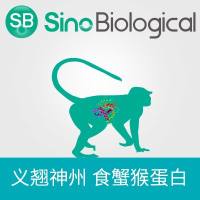Factor Xa Cleavage of MBP-Fusion protein
互联网
INTRODUCTION
In many cases the cleavage can be performed using the free intact fusion, or in same cases with the fusion protein bound to a matrix.
The amount of factor Xa, temperature and length of incubation must be calibrated for each system. Samples must be removed at various time points and analyzed by PAGE-SDS to estimate the yield, purity and extent of factor Xa digestion.
Factor Xa cleaves after the Arg residue in the cleavage site Ile-(Glu or Asp)-Gly-Arg. Ile and Thr are prefered after Arg, while hydrophobic residue is not recommended. Excess factor Xa may result in unwanted proteolysis at secondary sites.
Avoid the presence of serine-protease inhibitors (like PMSF) during reaction.
Theoretically, cleavage must be complete following ON treatment at RT with 10-30 ug Factor Xa from New England BioLabs per mg fusion protein. For some applications factor Xa (MW 43kDa consisting of two subunits of 27 and 16kDa) must be subsequently removed from the sample by chromatography or affinity with pAminoBenzamidine - Agarose.
Inactivation with 2µM dansyl-Glu-Gly-Arg-chloromethyl ketone (CALBIOCHEM #251700) or with 1mM PMSF.
Cleavage conditions according to QUIAGEN
Buffers: recommend 20mM Tris HCl pH6.5; 50mM NaCl and 1mM CaCl2. Optimum pH 6.5. Phosphate buffer reduce activity. Use TrisHCl or HEPES.
Detergents: Up to 1% Triton X-100, NP40 or n-octylglucoside.
Reductants: DTT not recommended. ß-Mercaptoethanol up to 5mM
NaCl: Decreasing activity at > 100mM NaCl.
Imidazol: Significant inhibition at > 100mM.
Incubation Temperature: Activity increases at higher temperature. Working conditions 4 to 37°C. Recommended: 22°C.
Reagents required
Factor Xa from New England BioLabs (#P8010S or #P8010L)
Factor Xa from NOVAGEN (#69037-3 or #69036-3)
Factor Xa from QUIAGEN (#33223)
Factor Xa Cleavage of Free Eluted Fusion protein
First you have to calibrate amount of Factor Xa, temperature and length of incubation, taking in mind that 1-3µg Factor Xa from New England BioLabs cleaves theoretical 100ug fusion protein in 16hr at 22°C in buffer.
You can incubate enough eluate to see on PAGE-SDS gels (~3ug) with 0.01, & 0.03 ug of Factor Xa 2hr, 4hr, 6hr & ON at 22°C (or RT). Stop the reaction with PAGE-SDS sample buffer + 1mM PMSF, boil 5min 100°C and keep immediately at -20°C until use. Analyze PAGE-SDS gels versus a control of non-cleavaged protein.
Longer incubation, more enzyme or higher temperature will increase cleavage; while lower incubation, less enzyme or lower temperature will decrease cleavage.
As a general protocol you can use:
1. To the eluate from either batch or column purification, add 10ug of Factor Xa solution per mg fusion protein.
2. Mix gently and incubate at RT for 2-16hrs
3. Once digestion is complete you can stop protease cleavage with 1mM PMSF and check results by PAGE-SDS gels or immediately separate the cleavage products by chromatography
4. When a satisfactory condition is found, scale-up the reaction proportionally.
Factor Xa Cleavage of Fusion protein Bound to column matrix
First you have to calibrate the amount of Factor Xa, temperature and length of incubation, taking in mind that 1-3µg Factor Xa from New England BioLabs cleaves theoretical 100ug fusion protein in 16hr at 22°C in buffer.
You can incubate 20ul of bed volume saturated Amylose-Agarose resin with 0.1, 0.3 and 0.5ug of Factor Xa 2hr, 4hr, 6hr & ON at 22°C (or RT). Stop reaction by spinning for 4min 3000rpm, separate supernatant from beads, and add PAGE-SDS sample buffer + 1mM PMSF to the supernatant, boil 5min 100°C and keep immediately at -20°C until use. Analyze PAGE-SDS gels versus a control of non-cleavaged protein (eluted non cleaved protein).
Longer incubation, more enzyme or higher temperature will increase cleavage; while lower incubation, less enzyme or lower temperature will decrease cleavage.
As a general protocol you can use:
1. For 1ml of bed volume saturated resin, mix 50µg of Factor Xa from New England BioLabs solution in 1ml PBS. Gently swirl to mix. Shake or rotate at 22°C (or RT) 2-16hrs
2. Spin the suspension 4min 3000rpm to pellet the beads. Keep supernatant aside. You can stop protease cleavage with 1mM PMSF.
3. Extract beads twice or more with 1ml PBS or buffer. Keep each supernatant aside.
4. As a control you can elute the remaining uncleaved protein (still attached to the resin through the Amylose-Agarose) by extraction several times with elution buffer.
5. Check results by PAGE-SDS gels or immediately separate the cleavage products by chromatography.
6. When a satisfactory condition is found, scale-up the reaction proportionally.
Factor Xa Removal with pAmino benzamidine-Agarose
Factor Xa can be removed by shaking or rotating at 22°C (or RT) 30 min with pAminoBenzamidine-Agarose (SIGMA #A 7155) (AmershamBiosciences#17-5123-10).








